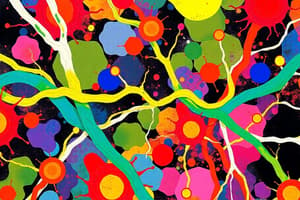Podcast
Questions and Answers
What role does Ca2+ play in the process of exocytosis?
What role does Ca2+ play in the process of exocytosis?
- It triggers the release of neurotransmitters into the synaptic gap. (correct)
- It inhibits the reuptake of neurotransmitters.
- It stabilizes the synaptic vesicles prior to release.
- It facilitates the depolarization of the neuron.
Which structure is primarily responsible for filtering harmful substances from the blood to protect the brain?
Which structure is primarily responsible for filtering harmful substances from the blood to protect the brain?
- Blood-brain barrier (correct)
- Cerebrospinal fluid
- Choroid plexus
- Circumventricular organs
Which of the following best describes decussation?
Which of the following best describes decussation?
- The synchronization of neuronal firing in the spinal cord.
- The process of encoding sensory information.
- The crossing of the midline that allows brain control of the opposite side of the body. (correct)
- The formation of myelin sheaths around nerve fibers.
What distinguishes the sympathetic division of the autonomic nervous system?
What distinguishes the sympathetic division of the autonomic nervous system?
What is the primary function of the cuneate fasciculus?
What is the primary function of the cuneate fasciculus?
Which layer is the thickest and outermost layer of the meninges surrounding the spinal cord?
Which layer is the thickest and outermost layer of the meninges surrounding the spinal cord?
What type of reflexes activate skeletal muscle in response to a stimulus?
What type of reflexes activate skeletal muscle in response to a stimulus?
Which of the following correctly defines proprioception?
Which of the following correctly defines proprioception?
What are the two types of cholinergic receptors?
What are the two types of cholinergic receptors?
What is the primary function of the gray matter in the brain?
What is the primary function of the gray matter in the brain?
Study Notes
Spatial Summation
- EPSPs from multiple synapses can add up to reach the threshold at the axon hillock to trigger an action potential
Calcium and Exocytosis
- Calcium is essential for the release of neurotransmitters into the synaptic cleft because it triggers the fusion of synaptic vesicles with the presynaptic membrane.
Locomotion
- The spinal cord contains Central Pattern Generators (CPGs), which are groups of neurons that coordinate repetitive muscle contractions for walking.
Meninges
- Dura Mater: The thick, outermost layer of the meninges.
- Pia Mater: The thin inner layer that lines the spinal cord.
Gray Matter (Spinal Cord)
- Consists of unmyelinated axons and cell bodies.
Lateral Horns
- Found in segments T2-L1 of the spinal cord.
- Part of the sympathetic nervous system.
Decussation
- The crossing of the midline in the brain, allowing one side of the brain to control the opposite side of the body.
Contralateral
- Origin and destination of a tract are on opposite sides of the body.
Ipsilateral
- Origin and destination of a track are on the same side of the body.
Cuneate Fasciculus
- Part of the ascending tract carrying sensory information from the upper body (T6 and above).
Nerve Tissue Coverings
- Endoneurium: Loose connective tissue surrounding each nerve fiber.
- Perineurium: Layers of overlapping squamous cells wrapping fascicles.
- Epineurium: Dense irregular tissue that wraps the entire nerve.
Plexuses
- Cervical Plexus: C1-C5
- Brachial Plexus: C5-T1
- Lumbar Plexus: L1-L4
- Coccygeal Plexus: S4, S5, and Co1.
Dermatome
- A specific area of skin innervated by a single spinal nerve.
Reflexes
- Somatic Reflexes: Activate skeletal muscles in response to stimuli.
- Visceral Reflexes: Automatic responses to stimuli involving glands, cardiac, or smooth muscle.
- Tendon Reflex: Inhibits muscle contraction to prevent over-stretching.
Gray Matter (Brain)
- Found on the outside of the brain.
White Matter (Brain)
- Located in the inner part of the brain, connecting different brain regions and the spinal cord.
Ventricles of the Brain
- Canals in the brain containing cerebrospinal fluid (CSF).
Functions of Cerebrospinal Fluid (CSF)
- Buoyancy: Provides support for the brain.
- Protection: Cushions the brain against trauma.
- Chemical Stability: Regulates the chemical environment of the brain.
Proprioception
- The non-visual sense of body position and movement.
Blood-Brain Barrier
- Protects the brain by controlling the passage of substances from the blood into the brain tissue at blood capillaries.
Brain Barrier System
- Protects the brain from harmful substances present in the blood.
Circumventricular Organs
- Areas where the blood-brain barrier is absent, allowing direct access to the brain for certain substances.
Medulla Oblongata Features
- Pyramids: Carry motor tracts.
- Olives: Relay signals for balance and coordination.
- Gracile and Cuneate Fasciculi: Carry sensory information from the body.
Spinal Tracts: Ascending
- 1st Order: Detects the stimulus and transmits the signal to the spinal cord or brainstem.
- 2nd Order: Carries the signal to the thalamus.
- 3rd Order: Carries the signal to the cerebral cortex.
Spinal Tracts: Descending
- Upper Motor Neuron: Starts in the cerebral cortex or brainstem and communicates with a lower motor neuron.
- Lower Motor Neuron: Located in the brainstem or spinal cord, controlling the target muscle or organ.
Cranial Nerves
- Vagus Nerve (CN X): Taste, sensations, gastrointestinal functions, heart rate.
- Trigeminal Nerve (CN V): Facial sensation, chewing, blood flow to the brain.
- Facial Nerve (CN VII): Facial expression, taste on anterior tongue.
Cerebellar Peduncles
- Connect the cerebellum to the brainstem.
Autonomic Nervous System
- Controls involuntary muscles (cardiac and smooth muscle) and visceral reflex actions.
Sympathetic Division (Autonomic Nervous System)
- "Fight or Flight" response, originating in the thoracic and lumbar regions of the spinal cord.
Parasympathetic Division (Autonomic Nervous System)
- "Rest and Digest" response, calming, digestion, uses cranial nerves III, VII, IX, X.
Sympathetic Tone
- Maintains partial constriction of blood vessels, influencing blood pressure.
Parasympathetic Tone
- Maintains smooth muscle tone in the intestines.
- Regulates the resting heart rate.
Somatic Motor Pathways
- Single myelinated neuron from the brainstem or spinal cord directly innervates skeletal muscle.
Autonomic Pathway
- Requires two neurons and a synapse in an autonomic ganglion to reach the target organ.
Adrenergic Receptors
- Receptors for the sympathetic neurotransmitters norepinephrine and epinephrine.
Parasympathetic Division Target Organs
- Rectum, bladder, distal colon, reproductive organs.
Enteric Plexuses
- Nerve networks within the walls of the gastrointestinal tract, independent of the spinal cord.
Cholinergic Receptors
- Nicotinic Receptors: Found on postganglionic neurons and produce excitatory postsynaptic potentials by opening ion channels.
- Muscarinic Receptors: Found on target organs, producing varied effects.
Alpha-Adrenergic Receptors
- receptors for norepinephrine, generally produce EXCITATORY responses.
Beta-Adrenergic Receptors
- receptors for norepinephrine, generally produce INHIBITORY responses and use cAMP as a second messenger.
Choroid Plexus
- Produces Cerebrospinal Fluid.
Efferent Neurons
- Motor neurons.
GABA
- The most common inhibitory neurotransmitter in the brain.
Acetylcholine
- Excites skeletal muscle and inhibits cardiac muscle.
Interneurons
- Found in the spinal cord and brain, connecting other neurons.
Mixed Nerves
- Contain both sensory and motor fibers.
Studying That Suits You
Use AI to generate personalized quizzes and flashcards to suit your learning preferences.
Description
Test your knowledge on key concepts in neuroscience, including spatial summation of synapses, the role of calcium in neurotransmitter release, and the structural organization of the spinal cord. This quiz covers essential topics such as the meninges, gray matter, and sympathetic nervous system function.





